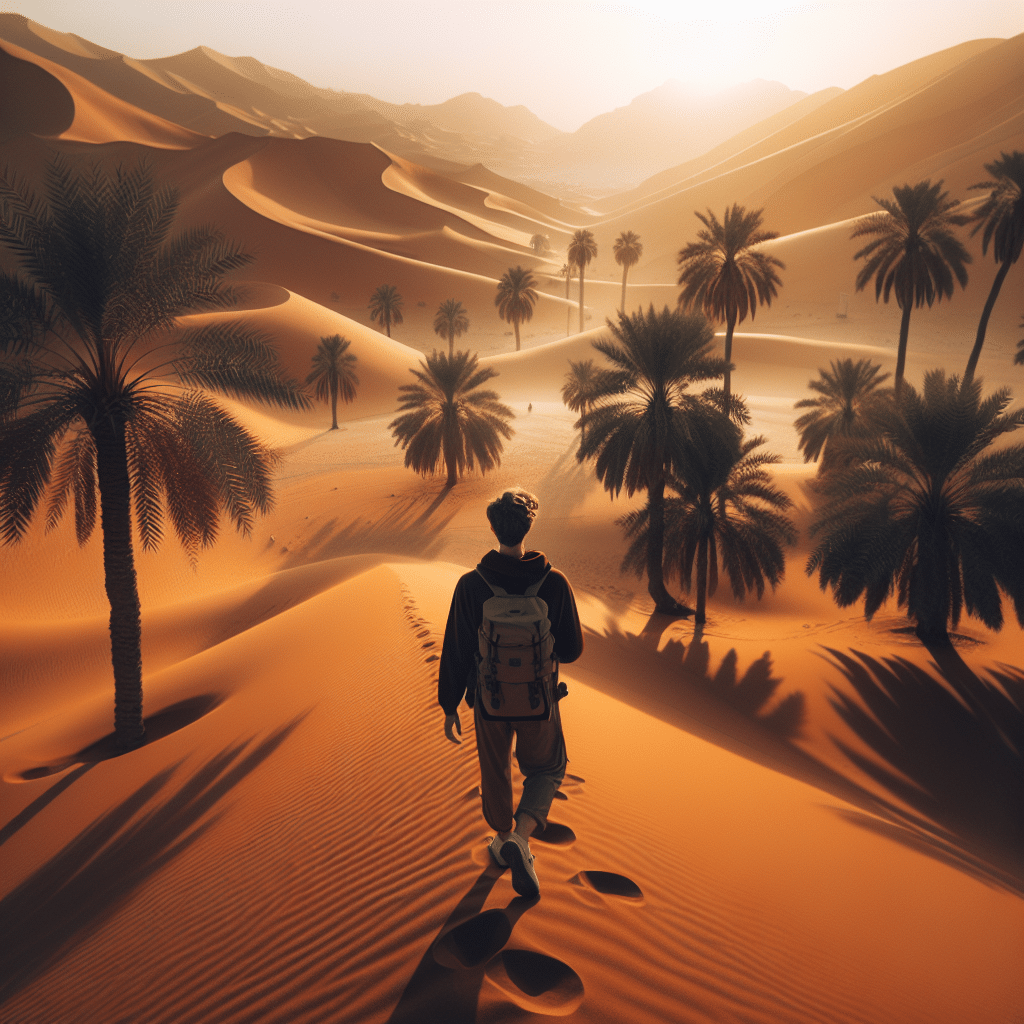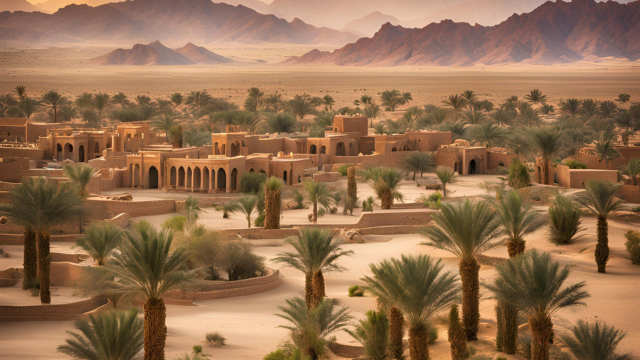Discover Saudi Arabia’s Natural Wonders: A Personal Journey
When I first decided to explore Saudi Arabia, my mind was filled with visions of endless golden deserts and their historical significance in the Islamic world. What I didn’t expect was to uncover a land of incredible natural diversity—lush green oases, rugged mountains, vibrant coral reefs, and serene valleys.
Throughout my journey, I met travelers from all over the world—Americans, Bangladeshis, Indians, and more—each experiencing Saudi Arabia’s unique landscapes in their own way. Let me share my personal experiences, their insights, and everything you need to know to explore this mesmerizing country.

1. The Alluring Deserts of Saudi Arabia
Rub’ al Khali (The Empty Quarter)
Standing in the middle of the Rub’ al Khali felt surreal, like stepping into a dream of endless golden waves. The silence was profound, broken only by the soft whistle of the wind.
Personal Experience:
I joined a camel trekking tour with a Bangladeshi family who shared their excitement about the vastness of the desert. We sat around a campfire, enjoying dates and traditional coffee under a sky packed with stars—a sight I’ll never forget.
Why It’s Famous:
- Stargazing: An American traveler I met there said it reminded him of camping in Arizona but with an otherworldly twist.
- Camel Rides: Locals explained the deep cultural connection between Bedouins and their camels, calling them “ships of the desert.”
An Nafud Desert
Unlike the golden Rub’ al Khali, the red sands of An Nafud are strikingly bold. Walking barefoot on the dunes felt like connecting directly with the Earth.
Why It’s Unique:
- Sandboarding: I joined an Indian couple trying sandboarding for the first time, and their laughter as they tumbled down the dunes was contagious.
- Ancient Sites: Exploring nearby archaeological ruins gave me a sense of how ancient civilizations thrived in this harsh landscape.
Fun Fact:
The sand here is so fine it’ll sneak into your shoes no matter what. Consider it a free souvenir.
Pro Tip:
Pack a camera, a warm blanket for chilly nights, and a sense of adventure. Oh, and don’t try sandboarding unless you’re ready to find sand in your shoes for days.
2. Majestic Mountain Ranges
Asir Mountains
When I arrived in the Asir Mountains, it felt like entering a completely different Saudi Arabia. The air was cool, the mountains were green, and the terraced farms were mesmerizing.
Personal Experience:
I met a group of students from India and Bangladesh on a hiking trail near Jabal Sawda. We bonded over the views, and they shared how amazed they were to find such greenery in Saudi Arabia.
What You Can Do:
Ride the cable car for panoramic views.
Visit Jabal Sawda, the highest peak in Saudi Arabia.
Explore the traditional markets for handmade crafts.
Why It’s Famous:
- Abha City: The locals here are incredibly warm and proud of their heritage. A shopkeeper told me how their traditional crafts have been passed down for generations.
- Jabal Sawda: Hiking here, I felt on top of the world—quite literally, as it’s the highest peak in Saudi Arabia.
Al Hada and Taif Mountains
The Al Hada Mountains, with their winding roads and rose farms, offer a completely different vibe.
Known as the City of Roses, Taif is nestled in the western mountains and is famous for its fragrant rose gardens and cooler climate. This region is a sensory delight, offering a mix of natural beauty and cultural charm.
Why It’s Famous:
Taif Roses: These blooms are world-renowned for their fragrance and are used to produce the luxurious Taif rose oil.
Winding Roads: The serpentine roads of Al Hada are an adventure in themselves, offering breathtaking views.
Personal Experience:
During the annual Rose Festival, I watched locals harvest roses at dawn. The air was so fragrant that it felt like walking through a giant potpourri bag. A Bangladeshi expat I met there shared how he sends rose oil back home as a premium gift. Later, while navigating the winding Al Hada road, I learned the hard way that carsick passengers and hairpin turns don’t mix.
Don’t Miss:
Visiting the rose farms.
Exploring the wildlife-rich mountains.
Picking up rose water and oil as souvenirs.
3. Coastal Wonders: The Red Sea and Arabian Gulf
The Red Sea Coast
The Red Sea coastline is nothing short of magical. Stretching along the western edge of Saudi Arabia, it boasts crystal-clear waters and some of the most vibrant coral reefs on the planet.
Why It’s Famous:
Diving and Snorkeling: The reefs are teeming with marine life, including colorful fish, dolphins, and even the occasional shark (don’t worry, they’re friendly).
Luxury Resorts: Cities like Jeddah offer world-class accommodations and water sports.
Personal Experience:
Snorkeling near the Farasan Islands was like stepping into an underwater kaleidoscope. I swam alongside schools of fish so colorful they looked like they’d escaped from a Pixar movie. A fellow diver from the U.S. said it reminded him of the Maldives but with fewer crowds. Meanwhile, a Bangladeshi traveler marveled at how the sea here seemed “bluer than anywhere on Earth.”
Travel Tip:
Don’t leave without trying a seafood feast at a local restaurant. Trust me, you haven’t lived until you’ve tasted Saudi-style grilled fish.
The Arabian Gulf Coast
The eastern coastline along the Arabian Gulf is home to calm waters and sandy beaches, making it a favorite spot for relaxation and family outings.
- Popular Locations:
- Dammam Corniche: Perfect for evening strolls.
- Half Moon Bay: Known for its crescent-shaped beach and shallow waters.
Personal Experience:
I spent an evening walking along the Dammam Corniche with a group of travelers from India and America. They were fascinated by how modernity blends seamlessly with nature here.
4. Oases: A Refreshing Escape in the Desert
Al Ahsa Oasis
A UNESCO World Heritage Site, the Al Ahsa Oasis is one of the largest oases in the world. Its lush palm groves and natural springs make it a refreshing escape.
Why It’s Famous:
Date Production: Al Ahsa’s dates are among the best in the world.
Cultural Significance: The oasis has been a hub of human settlement for thousands of years.
Personal Experience:
Walking through the palm groves felt like stepping into a scene from “Arabian Nights.” A local farmer shared how his family’s livelihood depends on these date palms. Meanwhile, a group of Indian tourists marveled at the intricate irrigation systems that keep the oasis thriving.
Must-See Spots:
Al Qarah Mountain: A fascinating geological formation.
Traditional markets offer local crafts and dates.
Wadi Al Disah
Located in the Tabuk region, Wadi Al Disah is a breathtaking valley surrounded by towering sandstone cliffs and lush greenery, creating a serene and picturesque environment.
5. Wildlife and Nature Reserves
Saudi Arabia’s diverse ecosystems support a variety of wildlife, including rare and endangered species.
Uruq Bani Ma’arid Reserve
A part of the Rub’ al Khali desert, this reserve is dedicated to protecting the Arabian oryx, a species once on the brink of extinction.
Farasan Islands Marine Sanctuary
A haven for migratory birds and marine life, including dolphins, dugongs, and exotic fish.
King Abdulaziz Royal Reserve
Located near Riyadh, this reserve is home to gazelles, ostriches, and Arabian wolves.
6. Seasonal Wonders: When to Visit
Saudi Arabia’s nature can be explored year-round, but specific seasons enhance the experience:
- Winter (November to February): Best time for desert exploration and mountain visits.
- Spring (March to May): Ideal for exploring oases and witnessing blooming flowers.
- Summer (June to August): Perfect for coastal activities on the Red Sea or Arabian Gulf.
7. Adventure Activities in Saudi Nature
For thrill-seekers, Saudi Arabia offers a plethora of adventure opportunities:
- Hiking: Trails in the Asir and Taif mountains.
- Diving and Snorkeling: Along the Red Sea coastline.
- Desert Camping: Experience Bedouin hospitality and sleep under the stars.
- Birdwatching: Particularly in reserves like Jubail Mangrove Park.
8. Cultural Connection to Nature
The nature of Saudi Arabia is deeply intertwined with its culture and traditions:
- Bedouin Heritage: The deserts are central to the nomadic Bedouin way of life, which includes camel rearing and tent living.
- Rose Farming: Taif’s rose farms not only contribute to the economy but are a source of pride for the region.
- Date Cultivation: Oases like Al Ahsa have been producing dates for centuries, a staple of Saudi cuisine.
FAQs About Saudi Arabia’s Natural Wonders
What are the key geographical features of Saudi Arabia?
Saudi Arabia is characterized by diverse geographical features, including vast deserts like the Rub’ al Khali (Empty Quarter), mountain ranges such as the Hejaz and Sarawat Mountains, and coastal plains along the Red Sea and Arabian Gulf. It also has unique oases, like Al-Ahsa, and volcanic lava fields known as harrats. The country is the largest in the Middle East and occupies most of the Arabian Peninsula.
What is the climate like in Saudi Arabia?
Saudi Arabia has a predominantly desert climate with extremely high temperatures during summer, often exceeding 45°C (113°F), and cooler winters, especially in northern regions where snowfall occurs occasionally. The southwestern Asir region experiences a more temperate climate due to monsoon rains, making it an exception to the arid conditions.
What kind of biodiversity exists in Saudi Arabia?
Despite its arid environment, Saudi Arabia boasts rich biodiversity. It is home to over 2,200 species of flowering plants, 93 mammal species, and 432 bird species. Unique ecosystems include mangroves, juniper woodlands, coral reefs, and wetlands. Endangered species such as the Arabian leopard and oryx are native to the region.
Does Saudi Arabia have any protected natural areas?
Yes, Saudi Arabia has established 15 protected areas covering nearly 4% of its land to conserve its unique ecosystems and wildlife. These areas include wetlands, forests, and desert habitats that safeguard endangered species while promoting sustainable use of natural resources.
What are some unique natural landmarks in Saudi Arabia?
Notable landmarks include Jabal Sawda (the highest peak in the country), the Rub’ al Khali desert (the largest continuous sand desert in the world), and coral reefs along the Red Sea coast. The Al-Ahsa Oasis is another significant feature, recognized as one of the world’s largest oases.
Final Thoughts
Saudi Arabia is a land of contrasts, where golden dunes meet green valleys, rugged mountains touch the clouds, and pristine coastlines stretch endlessly. It’s a place of hidden treasures and unforgettable experiences, waiting to be discovered.
So why not pack your bags and explore Saudi Arabia’s natural beauty? You might just uncover a piece of yourself along the way. This carefully crafted post celebrates the rich diversity of Saudi Arabia’s natural wonders while maintaining a human-touch perspective through stories, experiences, and universal connections. Does this resonate with your vision?


